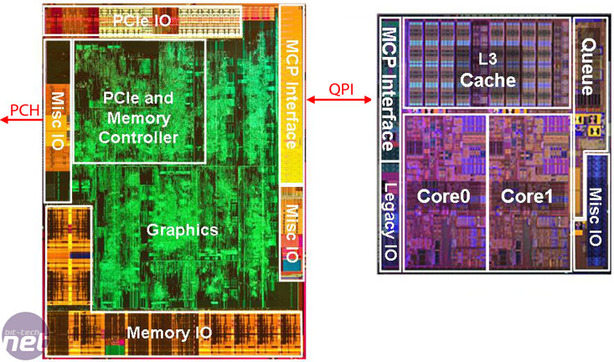Performance Conclusions
The actual overall bandwidth of Core i3 and i5 Clarkdale CPUs is a step up from what X48 and DDR3 offered, and certainly more than DDR2, however its access latency is terrible, even when you're not using the onboard GPU. It is only DDR3-1333 at Cl9 we're testing, but even then the Lynnfield CPUs are 50-60 per cent faster at getting to memory: that's a massive difference.The latest Clarkdale Core i3/i5s have a unified L3 cache which is a further step down in access latency, compared to the previous generation of Core 2 with their unified L2 caches. Clarkdale only has 4MB, so the cache is actually smaller than what was previously on offer. The CPU still has to handle the four threads and potentially four sets of data, so there's no less information being accessed.
Looking further into the design of Clarkdale proves instructive. They have a two die structure - a 32nm CPU and a second 45nm die. Don't, however, simply assume that this is just the GMA HD graphics. In fact, Intel simply shrunk and migrated its Northbridge onto the CPU, almost as is. The only change is that we no longer have a front side bus, where instead we find a very fast 6.4GHz QPI link (there's never been any mention of link-width in Intel papers however) between CPU and Northbridge.
The Northbridge die contains not only the graphics, but also the DDR3 memory controller, DMI link to the motherboard's chipset and PCI-Express too. Everything that needs CPU time still needs to go through this chip first - there's little direct performance gain from this design; instead we feel Intel has relied upon other elements of the CPU design (TurboBoost and 4MB of L3 cache) to take the strain away from this link.
That said, Intel's Core i7/i5/i3 design has always had very aggressive memory pre-fetchers and latency hiding has been an element all the way back to the Pentium 4 days, so oodles of nippy memory bandwidth aren't so much in demand because of the type of typical applications used with these CPUs. With Core i7 Bloomfield and Lynnfield CPUs it's not quite the case as they're directed towards the high performance workstation and server end of the market, where larger demands on memory through professional applications and heavy multitasking are made.
The Core i3/i5 products are fast in real life - there's no doubt about that - and we can understand why Intel has made the decision not to make its mainstream product too fast, only just enough to warrant a step up from its previous generation while still maintaining its Lynnfield and Bloomfield products as superior chips.
In fact, the situation is reminiscent of the way Intel's Core 2 Quad CPUs were technically inferior to AMD's CPUs - they were simply two dual-core dies slapped together, and needed to use the FSB to communicate - but in reality, the product was still successful because the execution cores were very quick, powerful and highly overclockable.
The bottom line? There's certainly room for improvement as regards Intel's consumer chips behaviour with DDR3, which is actually good news for Intel since DDR4 spec hasn't even been penned out by JEDEC yet. In its next generation we expect Intel to integrate everything onto the same die, making its DDR3 memory access more efficient, improving the performance for its future mainstream products again.
I suppose if I was at Intel, I'd be happy to have a fast product now and a very viable improvement path for the future.

MSI MPG Velox 100R Chassis Review
October 14 2021 | 15:04










Want to comment? Please log in.